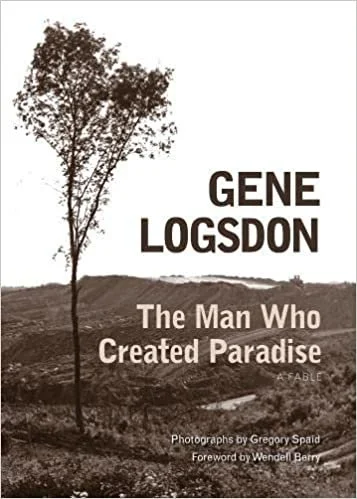Amid the strip-mined spoil banks of southeastern Ohio, one of the bleakest places in America, a bachelor farmer with a bulldozer and a dream has created a farm out of wasteland.
Wally Spero bought land that no one else wanted for five dollars an acre and went to work sculpting fields and ponds and groves of trees. After years of strenuous and calculated work, the spoiled hillsides were transformed into fields of verdant grasses divided by woven wire fences. Annual crops grew in the bottomland on either side of a creek that threaded the valley.
Spero's farm is centered on a little stone-walled house and a stone-and-wood barn built into one of the hillsides. Cattle and sheep graze on the hillside pastures. Chickens cackle in the barnyard. A sign on the barn reads "Paradise Farm."
Before he started farming, Wally was working as a metal grinder in a foundry and dreaming about being independent and living self-sufficiently.
"I realized right away there was a possibility of making enough money to live independently on a farm, once the land was paid for. That possibility seemed like heaven on earth to me," he explained.
After stashing away some savings and looking for an appropriate piece of cheap land, Spero found what he was looking for in the left-behind spoils of a mined-out coal field. He smoothed out the terrain with his bulldozer and when it came time to start planting, he left his job at the foundry to farm full-time.
"It's the only way a poor man can own a farm that I know of," Wally explains. "Make it yourself."
Paradise Farm doesn't really exist, however, or at least not the one that Wally Spero created. Both Spero and his farm are part of a fable written by Gene Logsdon titled The Man Who Created Paradise.
Logsdon, a former farm journalist turned farmer, is a Johnny Appleseed of small-scale farming in America, sowing the seeds of self-sufficiency and sustainable agriculture through books, articles and his own example on a small acreage in Upper Sandusky, Ohio. His fable about Paradise Farm is semi-autobiographical, written from the point of view of a farm magazine reporter who learns about Wally Spero through a letter and writes a feature article after visiting his farm.
The reporter, Gene Blair, returns to Paradise Farm more than 20 years later and discovers that not only has Wally Spero's farm survived and grown, but it has inspired others to join him in reclaiming the wasteland and a whole community has grown up around them on the former spoil banks of a strip mine: "The mini-farms were teeming with cottage industry. Potters were at work firing up their kilns. A winemaker was making a living from a fifteen-acre winery. Spinners and weavers labored at their wheels and looms, turning the wool from their sheep into clothing and blankets."
None of this really happened, of course, and Paradise Farm is not real. But there is a reality in the restoration of abused land and the economics of farming and the sustainability of low-impact agriculture. And the hopes and dreams expressed in this slender book are more than just a fable.
"In my opinion, if you think this is merely a fantasy, you had better be careful," writes Wendell Berry in the foreword to The Man Who Created Paradise. "If you can look at the landscapes produced by strip mining without reacting toward some vision of the land restored, then you are not only reacting to one of the versions of Hell; you are in it."

